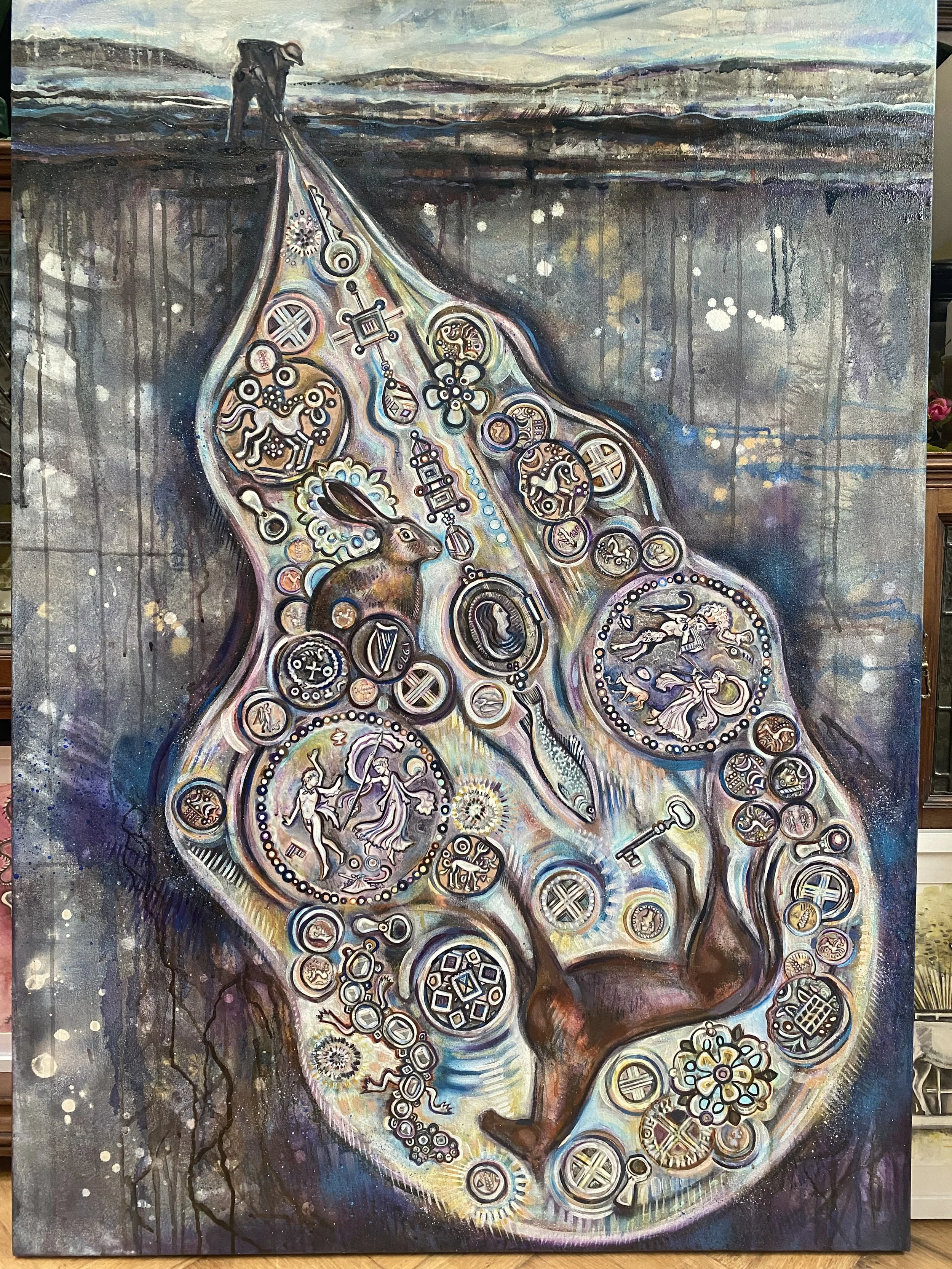Memory, Myth and the Emotional Archaeology of Place
‘I Know Where Shergar is Buried’ Mixed-media painting on canvas 2025
My most recent series of paintings explores layered ideas of identity, belonging, memory and inheritance through the lens of place — specifically the East Anglian and Essex landscapes where I grew up entwined with the threads of my Irish heritage. The work represents a kind of internal map, connecting the Irish blood that runs through my family stories with the English soil that has shaped my daily experience.
The emotional and conceptual core of the series is Seamus Heaney’s poem Digging, which has both haunted and inspired my creative process over many years. Like Heaney, I’m ‘digging’— in my case with brush, spray paint, charcoal, collage and symbol — into the ground of memory, myth, and meaning. These paintings are acts of excavation, uncovering both literal and metaphorical treasures: family folklore, working-class histories, personal and cultural artefacts and emotional truths buried beneath the surface.
One of the central works in the exhibition is ‘I Know Where Shergar Is Buried’, a nod to one of my dad’s tall tales about claiming to know where the IRA had hidden the champion racehorse. His stories were often fantastical and vivid and always came with the unanswered question, “Does he actually believe what he's saying?”. They form a key part of my personal mythology. This piece is at once an homage to his style of storytelling and a deeper meditation on the concept of buried truth. Where is the line between what is real and what is imagined and does that blurring of reality tell us more about ourselves than the “facts” ever could?
Further inspiration for my artwork comes from glittering archaeological treasures and the stories behind their discovery. A key influence is the Cheapside Hoard, a cache of Elizabethan and Jacobean jewellery unearthed by labourers in 1912 beneath a London street. I’m also drawn to extraordinary finds from East Anglia, including the Snettisham, Hoxne and Sutton Hoo hoards.
A personal favourite is the Mildenhall Treasure—a stunning Roman silver hoard found in 1946 in Suffolk. Beyond its artistic elegance, I love the story of its accidental discovery and the fact that its grand silverware was then put to everyday use - Sunday roasts served on the Great Dish - before its true value was realised. These forgotten treasures and their strange, human stories continue to feed the visual and narrative layers of my work.
The mystery of who buried it and why it was never reclaimed, speaks to the same tension I explore: the collision of ordinary working life with hidden opulence, of the everyday with the extraordinary of tall tales which just might have a basis in truth. I like to imagine a figure like my dad, a navvy in the 1960s, stumbling across such a treasure. There’s poetry in that. In the idea that hardworking hands can uncover stunning treasure.
This duality (low brow/high brow - culture clash) is echoed in the materials and techniques I use. The paintings are built in layers. The first marks are often drawings or collaged photographs of local landmarks from my hometown, fragments of architecture, medieval tiles, pop culture and half-forgotten places. Some of these are still visible, peeking through the surface like time capsules; others are obscured, buried beneath additional layers of spray paint, acrylic ink, and drawing. The result is a kind of visual archaeology — an intuitive, tactile process of covering and revealing that mimics the act of remembering.
I see these paintings as part folklore, part archive, part alternative universe — intimate dreamscapes where different times and influences collide. Small scraps of text, found paper and symbols are scattered across the compositions like clues, reflecting my impulse to collect, to arrange, to make sense of chaos. Each painting is a kind of paracosm: a personal world that creates order and meaning out of fragments.
Recurring symbolic elements — like peacocks, totem animals and mascots — act as emotional, superstitious signposts throughout the series. They’re echoes of the childhood belief that animals are lucky or magical and they speak to the imaginative ways we try to protect and understand ourselves.
This body of work is both a personal tribute and a wider reflection on place, memory and the stories we inherit. It celebrates the peculiar, the local, the poignantly strange beauty of home and the lingering possibility that my dad really did know where Shergar was buried.

